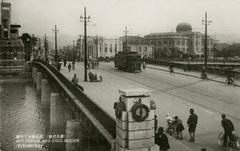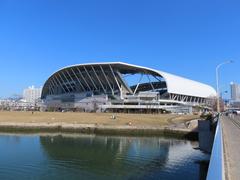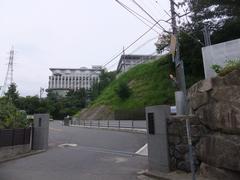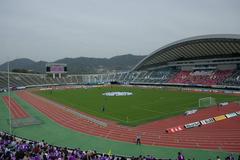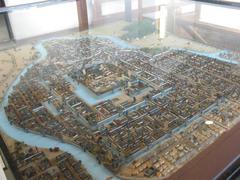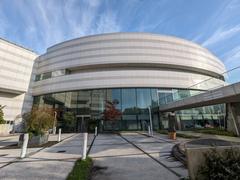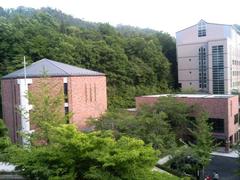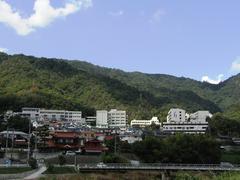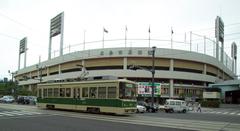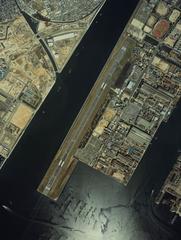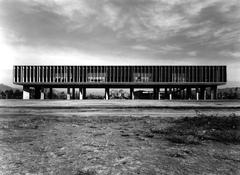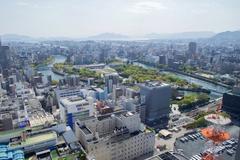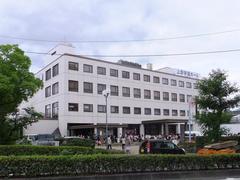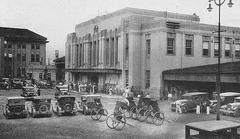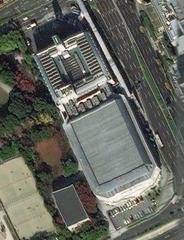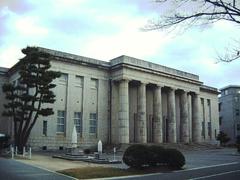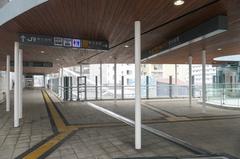
Visiting the Cenotaph for the A-Bomb Victims Hiroshima: Tickets, Hours, and Tips
Date: 04/07/2025
Introduction
The Cenotaph for the A-Bomb Victims, officially called the Memorial Monument for Hiroshima, City of Peace, stands at the heart of Hiroshima Peace Memorial Park as a powerful symbol of remembrance, resilience, and hope. Designed by renowned architect Kenzo Tange in 1952, its iconic saddle-shaped arch shelters the names of all those lost to the atomic bombing of August 6, 1945. The site not only honors the victims but also embodies Hiroshima’s ongoing commitment to peace and nuclear disarmament. Whether you are a history enthusiast, peace advocate, or traveler, this comprehensive guide details essential visiting information—hours, tickets, accessibility, nearby attractions, and practical tips—to ensure a meaningful and respectful visit (Nerd Nomads; Peace Tourism; Japan Guide).
Table of Contents
- Introduction
- History and Architecture
- Symbolism and Placement
- Cultural and Educational Significance
- Visitor Information
- Rituals and Living Memorial
- Visiting Etiquette and Practical Tips
- Suggested Itinerary
- Frequently Asked Questions (FAQ)
- Visuals and Media Suggestions
- Conclusion and Call to Action
- Sources and Further Reading
History and Architecture
Early Memorialization and Kenzo Tange’s Design
In the aftermath of the atomic bombing, Hiroshima’s citizens and leaders sought to honor the victims and advocate for peace. The Cenotaph, completed in 1952, became the first major peace memorial in the park. Kenzo Tange, a pivotal figure in modernist architecture, envisioned a structure that would blend ancient Japanese funerary traditions with modern materials. The arch’s form is inspired by haniwa—clay funerary figures—symbolizing a protective shelter for the souls of the deceased (Cestee). The use of reinforced concrete underscores both the monument’s durability and its modernist aesthetic (This City Knows).
Beneath the arch lies a stone chest containing the registry of all known victims, with new names added each year. As of 2024, over 303,195 names are recorded, affirming the monument’s ongoing role in remembrance (Nerd Nomads).
Symbolism and Placement
The Cenotaph’s location and design are deeply symbolic. Its arch, reminiscent of ancient Japanese sheltering roofs, offers both literal and metaphorical protection to the registry of victims. The monument is precisely aligned along the North-South axis of the park, forming a direct sightline from the Peace Memorial Museum, through the Cenotaph, to the Atomic Bomb Dome—a preserved ruin and UNESCO World Heritage Site (city.hiroshima.lg.jp). This alignment, known as the “Ideal View,” embodies Hiroshima’s transformation from devastation to hope and is preserved by city planning regulations.
The inscription on the monument reads:
“Let all the souls here rest in peace, for we shall not repeat the evil.”
Composed by Professor Tadayoshi Saika, this universal pledge transcends nationality and speaks to collective responsibility (japan365days.com).
Cultural and Educational Significance
The Cenotaph is central to annual peace ceremonies, held each August 6th, which unite survivors, families, dignitaries, and visitors from around the world in remembrance and renewed calls for nuclear disarmament. The monument also serves as a focal point for peace education, hosting school groups, activists, and international delegations throughout the year (japan365days.com). Its registry and inclusive design unify the surrounding memorials—such as the Children’s Peace Monument and the Flame of Peace—into a cohesive narrative of loss, resilience, and hope (Peace Tourism).
Visitor Information
Hours and Admission
- Cenotaph and Peace Memorial Park: Open 24 hours a day, year-round; free admission.
- Peace Memorial Museum: Adjacent to the Cenotaph; open 8:30 am–6:00 pm (hours may vary seasonally); modest admission fee (Japan Guide).
Getting There
- From Hiroshima Station: Take tram line 2 or 6 to Genbaku Dome-mae station (約15 min, 240 yen).
- By Bus: The Hiroshima Sightseeing Loop Bus (Meipuru-pu) also stops at the park.
- On Foot: The Cenotaph is centrally located between the Peace Memorial Museum and A-Bomb Dome (Japan Travel).
Accessibility
- The park and Cenotaph are wheelchair accessible, with wide paved paths and ramps.
- Accessible restrooms and multilingual signage (Japanese, English, and more) are available (hiroshima-vga.com).
Facilities
- Rest House (a historic building that survived the bombing) serves as a tourist information center.
- Public restrooms and tourist cafés are located near park entrances.
Nearby Attractions
- Hiroshima Peace Memorial Museum: Powerful exhibits and survivor testimonies.
- A-Bomb Dome: Iconic ruin, visible through the Cenotaph’s arch.
- Flame of Peace: Eternal flame burning until nuclear weapons are abolished.
- Children’s Peace Monument: Tribute to child victims, surrounded by origami cranes.
- Shukkeien Garden and Hiroshima Castle: Located nearby for a broader city experience (Intrepid Scout).
A self-guided walking tour of the park takes 60–90 minutes and covers all major sites (Just About Japan).
Rituals and Living Memorial
The Cenotaph functions as a living memorial. Each August 6th, new names are added to the registry, and the Hiroshima Peace Memorial Ceremony draws thousands for moments of silence, offerings of flowers and water, and the floating of lanterns on the Motoyasu River (Nerd Nomads). These rituals reinforce the monument’s role in collective remembrance and the pursuit of peace.
Visiting Etiquette and Practical Tips
- Quiet Reflection: Speak softly; maintain respectful silence, especially during ceremonies.
- Photography: Permitted, but be discreet and considerate of others.
- Offerings: Flowers and origami cranes are welcome gestures.
- Dress Modestly: Especially during commemorative events.
- No Food or Drink: Near the monument.
Best Times to Visit
- Early Morning/Late Afternoon: Offers tranquility and optimal light for photography.
- August 6th: Significant but crowded; early arrival is recommended for the ceremony.
- Cherry Blossom Season: The park is especially beautiful in late March–early April.
Suggested Itinerary
- Begin at the Peace Memorial Museum for context (allow 1–2 hours).
- Proceed to the Cenotaph for reflection and photography.
- Visit the Flame of Peace and Children’s Peace Monument.
- Conclude at the A-Bomb Dome.
- Optional: Extend your visit to Shukkeien Garden or Hiroshima Castle.
Guided walking or cycling tours are available for deeper insights (hiroshima-vga.com).
Frequently Asked Questions (FAQ)
Q: What are the visiting hours for the Cenotaph?
A: The Peace Memorial Park and Cenotaph are open 24 hours, year-round.
Q: Is there an admission fee?
A: No, visiting the Cenotaph and park is free. The museum charges a small fee.
Q: How do I get there by public transport?
A: Take tram line 2 or 6 to Genbaku Dome-mae station; the park is a short walk away.
Q: Are guided tours available?
A: Yes, local organizations offer guided tours in various languages.
Q: Is the Cenotaph accessible to wheelchair users?
A: Yes, with paved paths and ramps throughout the park.
Q: Can I take photographs?
A: Yes, but please be respectful—especially during ceremonies.
Visuals and Media Suggestions
- Photographs of the Cenotaph arch with the A-Bomb Dome framed in the background.
- Images of the Peace Memorial Ceremony and origami cranes.
- A map highlighting the North-South axis from the museum to the Dome.
- Virtual tours and interactive maps on official tourism websites.
Alt tags: “Cenotaph for the A-Bomb Victims Hiroshima Peace Memorial Park,” “View of A-Bomb Dome through Cenotaph arch.”
Conclusion and Call to Action
The Cenotaph for the A-Bomb Victims is a must-visit landmark for anyone seeking to understand Hiroshima’s history and the global aspiration for peace. Its accessible location, profound symbolism, and integration into the broader narrative of the Peace Memorial Park make it an essential stop for reflection and learning. For the latest updates, guided tours, and exclusive content, download the Audiala mobile app, explore our related articles, and follow us on social media for the latest on Hiroshima’s historical sites and events.
Sources and Further Reading
- Nerd Nomads
- Cestee
- Peace Tourism
- Japan Guide
- Official Hiroshima Peace Memorial Park Website
- city.hiroshima.lg.jp
- hiroshima-vga.com
- Japan Travel
- Japan Ryan
- Flashpacking Japan
- Hiroshima Virtual Museum
- Intrepid Scout
- Just About Japan
- JR Pass
- This City Knows












